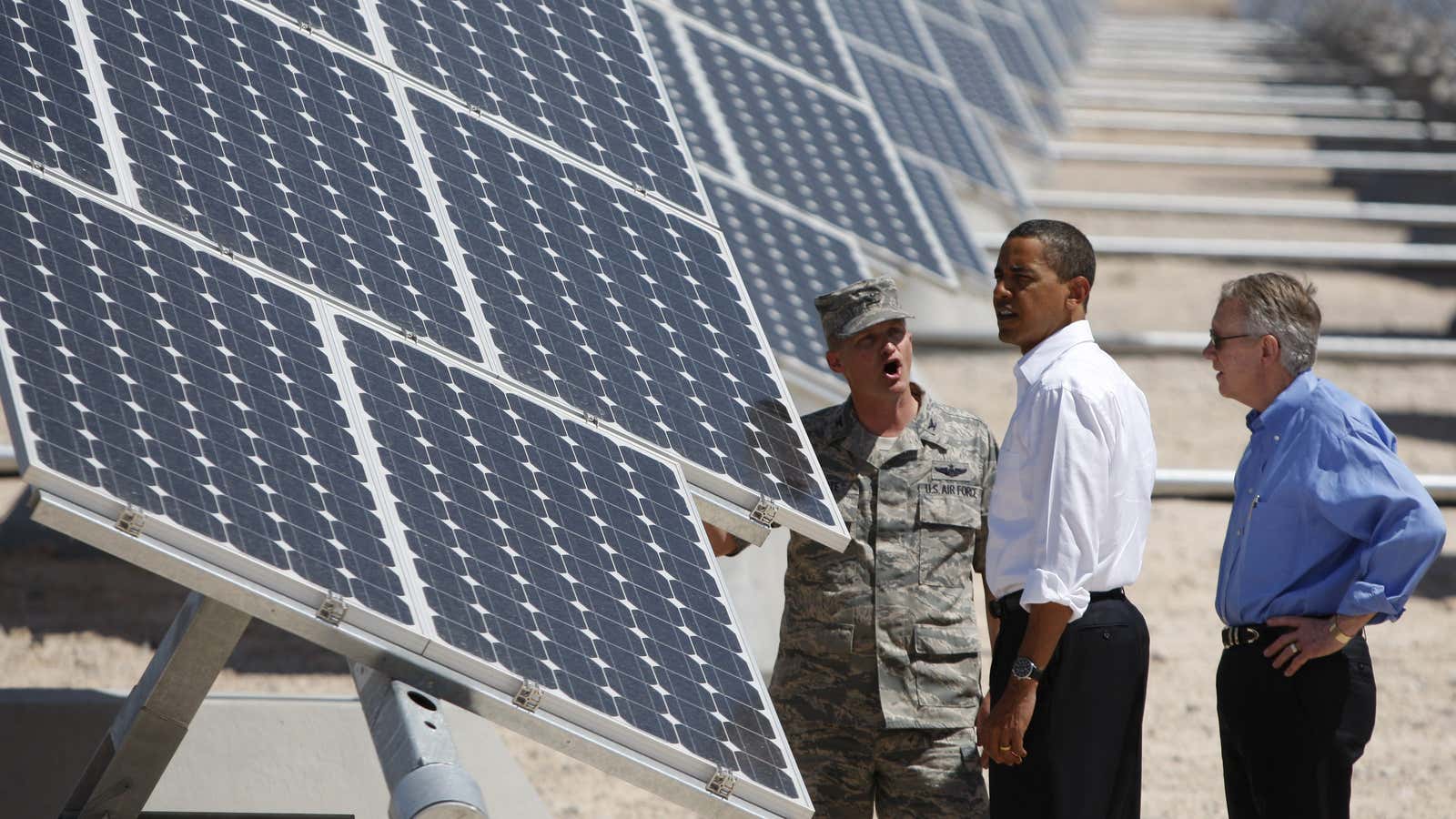In July 2019, the Virginia-based branch of German manufacturing giant Siemens landed a plum government contract: $829 million to overhaul the power plant that supplies electricity for the US Navy base at Guantanamo Bay, Cuba. The contract is the Navy’s biggest ever for energy efficiency upgrades. It includes lighting retrofits, air-conditioning upgrades, and replacing the base’s antiquated and highly polluting diesel generators with a combination of liquified natural gas and solar energy.
It’s a rare example of a Trump-era climate initiative—and even rarer, there’s a good chance that president-elect Joe Biden will follow suit.
Biden has promised that one of his first actions on climate will be to direct the government to clean up its $500 billion procurement budget, which pays for everything from pencils and office space to cars and fighter jets. Almost every contract presents an opportunity to opt for a product or service that has a smaller carbon footprint; by explicitly favoring such products, the government can help prop up clean industries. And for Biden, there may be no better place to start than the military.
The US Department of Defense (DoD) is far and away the government’s biggest energy consumer, responsible for more than three-quarters of total US government energy use at a cost of $12 billion annually, according to the Congressional Research Service. While president Trump spent most of his term slashing environmental regulations and climate initiatives in other parts of the government, measures to slash the military’s carbon footprint that began under Obama continued relatively unscathed, and are poised to gain even more momentum.
In fact, total defense spending on green products reached a record high of $30.8 billion in 2019, according to an analysis of federal data for Quartz by Gregory Sanders, deputy director of the Defense-Industrial Initiatives Group at the Center for Strategic and International Studies. That’s about 4.5% of defense department’s total 2019 budget.
What kind of line items fill out this more mindful military procurement? The list includes renewable energy installations, biofuels, products made from recycled materials, energy efficient appliances, and a wide range of other products that are designated as “environmentally preferable.” (It doesn’t include electric vehicles, which for the most part are leased to DoD from the Government Services Administration rather than purchased directly. It also leaves out nuclear power, which in this dataset is difficult to separate from the nuclear systems used to power some naval ships.)
Yet that big-picture figure conceals some challenges and opportunities for Biden. One is that under Trump, notwithstanding the splashy new facility in Cuba, spending on renewable energy dropped precipitously compared to Obama, especially for solar.
Recycled and energy efficient products filled the gap in overall green spending—but left the defense department lagging far behind on its congressionally-mandated target to use renewables for 25% of facility energy by 2025. In 2019, the figure was only 6%, according to the DoD’s most recent sustainability report.
Catching up should be a relatively easy win for Biden, said John Conger, a principal deputy comptroller for DoD under Obama and now director of the Center for Climate and Security, a think tank. Military bases in the US are well-suited to host large solar installations, he said, and under Obama, a number of bases signed power purchase agreements with solar companies, essentially leasing the land for solar panels in exchange for the power they produce.
“We were just allowing access to land we weren’t using,” he said. “That gave us a lower electric bill, and we were enabling huge amounts of renewable energy. Under Trump there was a de-emphasis on those projects, but those targets are still there, and they should be re-activated [by Biden].”
Making headway on renewables and alternative fuels is especially important, Conger said, because the biggest contributor to DoD’s carbon footprint remains much harder to fix: aviation fuel. Jet fuel accounts for more than half of total defense energy use, and can’t yet be easily replaced with low-carbon alternatives. Low-carbon vehicle and naval fuels got a much-publicized push under Obama, but also fell off during Trump’s term, the DoD report found.
Solving the aviation problem will be a matter of R&D spending, not procurement; a recent report from Columbia University’s Center for Global Energy Policy recommends that DoD boost its energy research budget by $250 million in part to study this challenge. It’s a target with potentially enormous benefits for the private sector—and, by extension, trickle-down political benefits for Biden—since the airline industry is also desperate to curb its reliance on oil.
Biden could also push Congress to extend legally-required fuel efficiency targets to combat vehicles, which are currently exempt. There are plenty of bipartisan, security-focused reasons to do so, Conger said. Getting gas to into conflict zones can jack the price up to anywhere from $40 to $600 per gallon, fuel convoys are a common target of attacks, and an over-reliance on imported oil leaves the military vulnerable to price shocks and supply chain disruptions, according to a recent Government Accountability Office report.
“For DoD it will always be about mission, rather than emissions,” Conger said. “But you can transform what you buy, which is a lot, into things that are going to have a better carbon footprint.”




